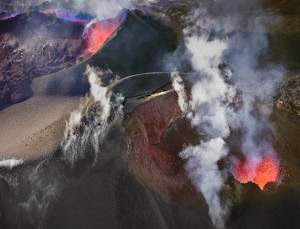
OUR planet is home to a glorious variety of animals, but it might not have been. Were it not for the birth pangs of a mega-continent, the evolution of animals could have stopped at its earliest stages.
We now have the best evidence yet that an enormous wave of volcanism, caused by several continents crashing together to form the even greater landmass known as Gondwana, was the reason for a sharp rise in global temperature. This change was the driving force for evolutionary explosions that made life more diverse and laid the foundations for all future animal species.
Volcanoes can cause global warming because eruptions often spew huge amounts of the greenhouse gas carbon dioxide. Now a study of volcanic rocks from early in life’s evolutionary story shows that such eruptions coincided with a change in the climate from frigid chill to sweltering heat.
This swing, and the way it affected the oceans, caused an explosion of evolutionary diversity, followed by a mass extinction when temperatures got too hot. Then, when Gondwana had formed and the volcanism died down, the planet cooled and life began to bloom again. The findings add to evidence that plate tectonics and living things are linked (see “Shaky worlds may harbour life”).
Last year, a study suggested that microbes helped form continents by encouraging volcanic activity (New Scientist, 23 November 2013, p 10). Now Ryan McKenzie of the University of Texas at Austin and colleagues have shown that, in turn, volcanism may have shaped life during the crucial Cambrian period .
Before the Cambrian, over 600 million years ago, Earth was virtually covered in ice. The first animals arose on this “Snowball Earth”, but these “Ediacarans” did not look like modern animals.
Then came the Cambrian explosion. “You had single cell organisms, single cell, single cell, then weird Ediacaran oddballs, and – suddenly – snails and bivalves and sea stars and a whole range of groups that typify the record for the rest of time,” says McKenzie’s colleague Paul Myrow of Colorado College in Colorado Springs.
The animals that appeared during the Cambrian explosion gave rise to all the major groups alive today, from worms to starfish. But each group only contained a few species, and got no further. The next period is known as the Dead Interval, and was marked by mass extinctions. It was another 50 million years before animal life blossomed once more, during the Ordovician.
We already knew that Earth’s temperature changed dramatically over these periods. It thawed in the early Cambrian then became stiflingly hot during the Dead Interval, before cooling again. “These are huge climate swings, from Snowball Earth to one of the warmest intervals of Earth history in the Cambrian,” says Lee Kump of Penn State University in University Park.
Volcanic activity during the formation of Gondwana has been suggested as a driver of these violent changes, but Kump says the evidence for increased volcanism was “a house of cards”.
McKenzie’s new evidence comes from tiny zircon crystals. Zircons are only formed in particular volcanic eruptions that are triggered when continental masses crash into each other, so they act as a record of past continental collisions. McKenzie assembled zircon counts from rocks laid down in the last 3 billion years, from all around the world.
He noticed that zircons were rare from Snowball Earth but common in the Cambrian. It seems a horde of volcanoes began spewing just before the Cambrian, and their activity reached a peak during the Dead Interval (Geology, doi.org/qvp).
“We hypothesise that CO2 outgassing from continental volcanic arcs drove major climate shifts,” says McKenzie.
Kump agrees: “This to my knowledge is the first direct and compelling assessment of changes in arc volcanism over this critical interval.”
“This is a fundamentally new and radical idea,” says Cin-ty Lee of Rice University in Houston, Texas.
Myrow says the formation of Gondwana offers the best explanation for the extra volcanoes. “Throughout the Cambrian two big continental masses were coming together to make Gondwana,” he says. The collision generated infernal heat that melted rock and created long chains of volcanoes. “You’re making volcanoes like mad,” says Myrow. “They produce carbon dioxide and temperatures get very, very hot.”
As well as heating the planet, the extra CO2 acidified the oceans. Many ocean creatures are sensitive to changes in acidity, so this could help explain the Dead Interval. Then the volcanism died off once Gondwana had formed, CO2 levels fell and a huge diversity of reef-based animals appeared.
“Now we have greater confidence that volcanism and its effect on the greenhouse gas content of the atmosphere drove climate change in deep time,” says Kump. “This had direct effects on rates of biotic diversification.”
Changes in tectonic activity would go on to affect life on Earth throughout its history, but not always in such a helpful way. For instance, almost all animal and plant life was abruptly wiped out at the end of the Permian period 251 million years ago, a time known as the Great Dying. Rapid climate change triggered by intense volcanic activity could well be to blame. Tectonics may give, but it also takes away.
Note : The above story is based on materials provided by Catherine Brahic Magazine issue 2952. © Copyright Reed Business Information Ltd.










